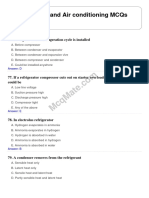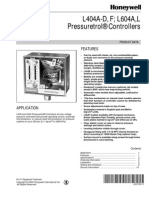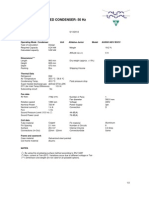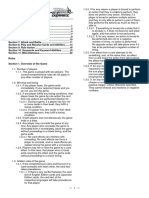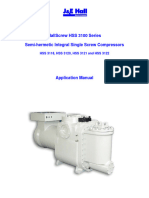© Danfoss A/S (RA Marketing/SB/mwa), July 2008
1
|
TECHNOLOGY
|
Electronic Expansion Valves
Electronic Expansion Valves
Fitters Notes (Part 8)
Stephan Bachmann, Danfoss Refrigeration & Air Conditioning, Offenbach
Lately we have received a lot of customer questions about using electronic expansion valves, so the eighth instalment of Fitters Notes is entirely dedicated to this topic. Optimal evaporator filling (even with large load variations), flexible MOP points, and using the highest possible evaporating temperature in order to increase energy efficiency are topics that always interest refrigeration system engineers and operators. In many cases, theses requirements cannot be fulfilled adequately with standard thermostatic expansion valves. Electronic expansion valves, by contrast, are very well suited to the task.
Low superheat, higher evaporating pressure, and better COP
The advantages of an electronic superheat controller are obvious. The evaporator is always optimally filled with refrigerant. Even with large load variations, which means an extremely wide range of partial-load operating conditions, exactly the right amount of refrigerant can be injected. This is done by constantly sensing the actual superheat value in the evaporator by means of a pressure transducer (labelled “P” in Figure 1) and a very sensitive temperature sensor (“S2” in Figure 1) and conveying this information to the controller (EKC 315A) in near real time. With this information, the controller can act to achieve an optimally low superheat level. This adaptive regulation of refrigerant injection leads to optimal utilisation of the evaporator and thus to the highest possible evaporating pressure that can be achieved in the system concerned. This not only results in higher COP values, but also leads to energy savings because the COP value is equal to the cooling capacity divided by power consumption.
Constant superheat optimisation
The superheat always adjusts to the minimum stable signal (MSS line) of the evaporator, which reliably prevents any signal drift into the instable region (to the left of the MSS line in Figure 2). The EKC 315A controller initially selects an arbitrary superheat set-point value, such as 8 K. Then it tries to achieve this value (8 K) as the set-point value of the system. As all of the information – the superheat temperature “S2” and the current evaporating pressure “P”– comes together here, and in addition the past history of these two parameters is stored for optimisation of the control function, the controller can easily decide whether the value it is currently trying to achieve is actually feasible under the currently prevailing load conditions. For example, if the evaporating pressure fluctuates strongly and the superheat value changes quickly, this is a sign that the controller should try to achieve a higher superheat set-point value. On the other hand, if the superheat and the evaporating pressure remain largely constant, the controller can continue operating with successively lower superheat set-point values, such as 7 K, 6 K, 5 K, and so on. Constant verification of the optimal superheat level is a decisive advantage of electronic expansion control valves relative to purely thermostatic valves. Thermostatic valves must be set in advance to the maximum superheat set-point value corresponding to the specific MSS characteristic of the system. However, this value is not especially easy to determine, so the already poor initial situation is usually made even
E v a p o r a t o r c a p a c i t y r a n g e E v a p o r a t o r c a p a c i t y r a n g e
Min. stable signalActual superheatMin. stable signalActual superheatSuperheatSuperheatMSS = f (Q
o
, T
o
etc.)MSS = f (Q
o
, T
o
etc.)
Electronic injection system



2
© Danfoss A/S (RA Marketing/SB/mwa), July 2008
|
TECHNOLOGY
|
Electronic Expansion Valves
worse by the fact that the installer adds a safety factor to the required minimum superheat value at start up. With regard to the operational reliability of the system, this is not a bad idea, since somewhat higher superheat is certainly preferable to occasional “shooting through”. However, this measure has a negative impact on the energy efficiency of the system. With the EKC 315A electronic injection system, this safety margin is not necessary because the superheat level of the system is adjusted automatically as described above.
Freely selectable MOP point
An important aspect of electronic injection control that is often overlooked is that the MOP point is freely selectable. As described in the two instalments on thermostatic expansion valves, the MOP point relates to the maximum evaporating pressure (MOP stands for “maximum operating pressure”) of the expansion valve. Thermostatic expansion valves always have very specific MOP points (if they have a MOP point at all), so you have to select a different part for each application (for example, –20 °C for freezer applications or +15 °C for an “airco MOP”). The MOP is freely selectable with an electronic expansion valve, and if necessary it can be tweaked or changed to a completely different value. This means that in most cases you can manage without a crankcase pressure regulator, which amounts to a significant cost saving with a relatively large system. In addition, setting the desired set-point is faster and more convenient with the electronic version than with a mechanical crankcase pressure regulator.
Operation
The controller is operated using two pushbuttons. You can use these two buttons and the three-digit display to program all of the controller settings and display all important data. This enables every installer or service technician to alter the control loop settings or display relevant data. In addition to using the controller’s menu to display all configurable parameters, such as the refrigerant type, you can modify the stability and gain factors in order to precisely tune specific processes. For instance, you can adjust the superheat controller to prevent cycling of the superheat value. You can also select either adaptive superheat control or load-dependent control. We already described the adaptive superheat control mode in detail. In the load-dependent superheat control mode, the system is intentionally operated with higher superheat in certain partial-load situations, for example in order to ensure longer minimum compressor running times or improve the icing behaviour of the evaporator. This makes it possible to skip defrosting from time to time.
Service
The Service menu of the electronic superheat controller is particularly useful for installers during system commissioning, as well as service technicians during system maintenance. All parameters that begins with “u” show system values that are significant for all types of troubleshooting and assessing system states. Three parameters are especially important in this regard: “Show superheat”, “Show temperature at S2 sensor” (which means at the evaporator outlet), and “Show evaporating temperature”. These three values provide information about the state of the system. For one thing, they can be read out quickly, which saves you the effort of using a service pressure gauge and service thermometer to determine them. In addition, you can see immediately which values the controller has accepted as its settings. For example, with an electronic system an experienced installer will routinely check all the sensors before putting the system into service (with the usual resistive sensors, this can be done quite easily with an ohmmeter – for instance, a Pt100 sensor has a resistance of 1000 ohms at 0 °C) in order to avoid time-consuming troubleshooting if a sensor does not show the correct value. If you simply scan through the service menu, you can eliminate this procedure because you can judge directly whether the value is realistic (and in case of doubt, you can check it with the thermometer or manometer).
Manual output relay operation
Naturally, the outputs of the controller are just as important as the inputs. Specifically in order to make this aspect easier during commissioning, the controller menu allows you to manually override the outputs for the AKV valve, the solenoid valve and the alarm. A typical question in case of control problems is whether the controller is not switching the output because it doesn’t regard this as necessary (for some reason) or the output is not switching due to a fault of some sort. This question has cost even experienced installers hours or even days of troubleshooting time. For this reason, it is advisable to thoroughly check each of the relevant output relays for proper operation when you are putting a system into service. This is also a quick way to sort out wiring errors and misconnections.
Continuous electronic valves
You always have the choice of using an ETS, ICM, or AKV valve. These actuators differ as follows: the ETS and ICM are continuous valves, so they are often used in chillers with R407C refrigerant when every degree of superheat counts and even the slightest variation in the evaporating pressure must be avoided. The controller can be used as a P, PI, or PID controller. With P control, the controller provides conventional control proportional to the control error (for example, if the superheat becomes too large, the valve opening is always increased at the same rate).
© Danfoss A/S (RA Marketing/SB/mwa), July 2008
3
|
TECHNOLOGY
|
Electronic Expansion Valves
With PI control, the “reset time” (the “I” component) can be adjusted independently. This means that the response time of the controller can be adjusted, or in other words, the controller can be made more jittery or more sluggish. Either one may be necessary. The “D” component with a PID controller further improves the control response to sudden changes in the set-point value. This control mode is especially advisable if the injection system is operated with external superheat set-point shifting – for example, from a higher-level controller. If an ETS or ICM valve is used, a solenoid valve should also be fitted in the liquid line and controlled by the EKC as well. In situations where it is necessary to do without the solenoid valve, it is essential to connect an uninterruptible power supply (UPS) to the actuator (ICM) and/or the controller (ETS). This is absolutely necessary because an ICM or ETS will maintain its current opening position if there is a sudden loss of electrical power and thus continue to inject refrigerant into the evaporator, which can lead to major damage or even failure of the compressor. With a UPS, the valve can always be closed even under such conditions.
Pulse-width modulation
In systems that use pulse-width modulation with an AKV valve, it is not necessary to fit an additional solenoid valve in the liquid line because the valve can constantly block the flow of refrigerant, and it automatically returns to the closed position in case of electrical power failure. The EKC/AKV combination operates in pulse-width modulation mode. This means that depending on the desired valve opening, the AKV valve is fully open for a certain part of each period and fully closed for the rest of the period. For example, with a 50% opening and a standard pulse interval of 6 seconds (this value can be adjusted), the valve is open for 3 seconds and closed for 3 seconds. With 20% opening, the corresponding values are 1.2 seconds open and 4.8 seconds closed.
Dimensioning the liquid line
Particularly when a pulse-width modulated valve is used, extra attention must be given to the dimensioning of the liquid line. In the relevant technical literature, a speed of 0.5 m/s is usually stated as a guideline value for determining the diameter of the liquid line. However, if you examine actual refrigeration systems you will see that the value is closer to 1 m/s. As this usually does not create a problem for normal (continuous) thermostatic expansion valves, this value has largely become established as a rule of thumb. However, the situation with pulse-width modulated valves is different. Here you should go so far as to use the figure of 0.5 m/s as the design value for the maximum valve capacity, rather than just the evaporator capacity. Following this rule, most system engineers would probably specify 12-mm copper tubing for the liquid line with a 7-kW evaporator in a system with R404A and an evaporation temperature of –10 °C (without special subcooling). The flow rate in this case would be 0.92 m/s, which is certainly within the normal range. With strict application of the 0.5-m/s rule, 15-mm or 16-mm tubing would be necessary to obtain a value of approximately 0.5 m/s. Finally, if you consider the valve capacity instead of the evaporator capacity, it might even be necessary to use 18-mm tubing (example: valve capacity 10 kW; AKV valves are never designed for 100% opening, so the design should be based on opening values in the range of 30% to 70%). If you observe this principle, the system will usually be free of accelerated liquids, which otherwise often form a source of tubing noise and can cause tubing vibration. In such a system, electronic injection is just as good as a conventional thermostatic system with regard to service life and reliability.
Humidity
Refrigeration specialists know that the subject of moisture in the air plays an especially important role in refrigeration engineering, especially with unpackaged goods, meat, vegetables and fruit. Nevertheless, this topic is not tackled as aggressively here as it is with comfort air conditioning systems, in which suitable hygrostats and humidifiers are used on a broad scale if the humidity level is too low. However, dehumidification may be necessary in refrigeration systems, depending on the situation. This is usually achieved by indirect means, such as adjusting the evaporator fan speeds
Period (PD) = 6 secondsOpeningdegree(OG)% =OT x 100PDOT = Opening Time
A K V O G %
Time
AKV openAKV closed
12 seconds
4
© Danfoss A/S (RA Marketing/SB/mwa), July 2008
or the evaporator speed. (For example, a lower fan speed results in a lower evaporating temperature, which causes dehumidification, and vice versa). This aspect can be controlled directly with an electronic injection system: simply use an external 4–20-mA signal to shift the superheat set-point value, and you can obtain little or no dehumidification with the smallest possible superheat or high dehumidification with high superheat. Of course, the rule that the temperature must always be below the dew point for dehumidification still applies. Such a system can always be fine-tuned
Information
The “Fitters Notes” series is based on the handbook of the same name produced by Danfoss, which discusses the basic principles of commercial refrigeration systems and the associated basic components.You can view the Fitters Notes handbook from here:
http://www.danfoss.com/BusinessAreas/RefrigerationAndAirConditioning/EducationAndTraining/Fitters+Notes.htm
This “Fitters Notes” series is aimed at refrigeration fitters in servicing, system construction, people entering refrigeration engineering from other disciplines, trainee refrigeration fitters and anyone who would like to gain a basic practical knowledge of refrigeration in a series of articles. The discussion avoids formulae as far as possible and only a small amount of prior technical knowledge is necessary. Fitters like using rules of thumb and so we will provide plenty of them, even if this sometimes makes it necessary to accept generalisations that are not always entirely accurate from an academic viewpoint. Unless otherwise stated, this series always refers to refrigeration systems using fluorinated hydrocarbons, such as R134a, R404A/R507 and R407C (i.e. not ammonia refrigeration systems).
|
TECHNOLOGY
|
Electronic Expansion Valves
quite easily based on the amount of condensation deposited on the evaporator. Aside from vegetable and fruit storage, a system of this sort is also suitable for comfort air conditioning HVAC systems and cabinet-type coolers.
Remote service
Remote service is always possible with this type of control system. The controller can be fitted with an LON module, and the appropriate data can be recorded by a master unit or the control system can be accessed via a local modem connection. This can be done using a special software tool (Danfoss AKM). This makes it possible to integrate the electronic injection system into complex Danfoss control system networks if desired.
Preview of the next issue: scroll compressors
This concludes our brief excursion into the world of refrigeration system electronics. In the next issue, we turn our attention to scroll compressors.















































